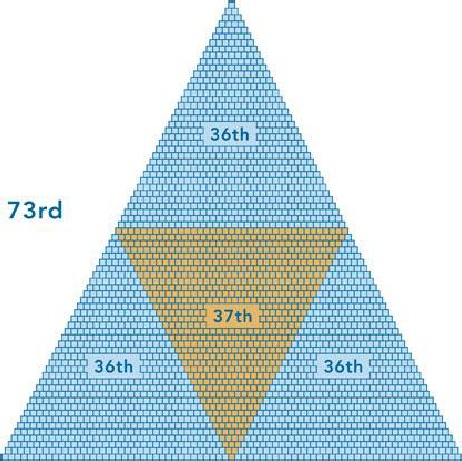Shavuot celebrates the day the nation of Israel received its Torah (the Bible) and is associated with blossoming trees, flowers, milk and honey. Honey is the only kosher product that comes out of a non-kosher producer. So what were Israel's greatest scholars and mystical thinkers trying to convey as to uniquely regard it in Jewish law? The paradox that kosher honey comes from a non-kosher honey bee suggests more than meets the eye.
In a recent documentary series on shapes in nature, mathematician Marcus DuSautoy did a great job revealing honeycombs hexagon shape, which he declared to be nature's most efficient because of the number of sides it can share with its neighbors.The beehive's symmetrical compartments differ from anything else in nature where order is usually affected by disorder or entropy resulting in the rugged irregular appearance of natural objects. For example the disorder in nature can be seen in trees and their branches, or mountains, or snowflakes where one in a million may approach perfect symmetry, but almost all never quite make it.
The interest in symmetry and its relationship to the natural world has a long history. The Ancient Greeks became obsessed to discover nature's underlying building blocks and Plato identified five perfect symmetrical shapes well before modern science could see molecular structures. Several thousand years before, the great mystics had already reached their conclusions about nature and symmetry. The most sophisticated and earliest living document used by the Greeks in their quest for insight into nature was Hebrew's 22-letter alphanumeric Torah -- The Bible. Here's a glimpse of their discovery in the numerical values of the first seven words of the opening verse (read from right to left);

- 2,701 is the total value of each letter added together, which is also the addition of all numbers from 1 to 73 known as the "triangle" of 73 that can be expressed as '73 X 37'.

- The largest triangle is the 73rd drawn with 2,701 blocks. It contains the inverted 37th drawn with 703 blocks, and three 36th triangles each with 666 blocks.

- The hexagram of 73 "stars" above contains the inner hexagon of 37
- 18 (purple) stars representing 666 and 19 (tan) stars representing 703 -- the whole number midpoints of the 36th and 37th triangles.
Thus, the words in the opening line of Torah exhibits symmetry that is not visible in nature where disorder prevails. So why reflect perfect order for the verse in which the natural world is created in seeming contradiction to natural disorder? This question fascinated the Greek thinkers who through their observations of the material world revealed mathematic and scientific distortions they would use to undermine the logic of Torah's unified spiritual proposition.
Whilst the Greeks were leading the world to adopt a more material than spiritual philosophy, Israelites were focussed on building their Temple culture and spiritual conditioning, which from time to time was lacking. Ancient Jewish spirituality drove the materialistic Greeks crazy; they could not comprehend how Jews could follow a text promoting belief in and homage to a monotheistic God no-one could see, touch or render. The maddened Greeks capitalized on Jewish disunity conquering and defiling Israel's holy Temple in Jerusalem where God might dwell.
In the natural world, the Torah represents the Lord God by His female virtues, referred to as the Queen, and the Jewish assembly is strongest when He is inherently present in their minds. The spiritual logic is reflected in the actions of worker bees that perfect natural disorder by serving the greater purpose of their queen. Indeed, this is the archetypal model for their successful existence. And so it is true with the Jewish people as well, for the more Jews become subjugated to this principle of spiritual unity and symmetry in their Torah, the more powerful their nation becomes and when they embrace this psychological disposition, the nations of the world, its plants and trees, reap benefits.
The paradox that kosher honey emerges from non-kosher bees can now be understood. In nature, where disorder is the trending characteristic, order is achieved with reverence, whether imagined or real. In the unifying principle of monotheistic deference, which Torah proposes in its opening words, disorder is ordered. The bee is a worker devoted to lifelong service of its queen and the Jew pursues the same dedication to the unending unity of Queen and King that is the God of Israel. Therefore, the bee represents the model "state of being," an impure vessel producing that which is pure. The vessel never becomes kosher; however, through the bees' unquestioning commitment and service, pure honey -- the product of the bees effort -- is awarded its unique recognition in the Jewish laws of Torah.
For the skeptical reader, the analogy may not appear obviously true until it is understood that order is the judicial ideal woven into Torah's laws. The symmetry of these laws directs the willing subject, one step at a time, to improve conditions as the world approaches its "butterfly effect" -- a state of perfect world order and ultimately peace for all.